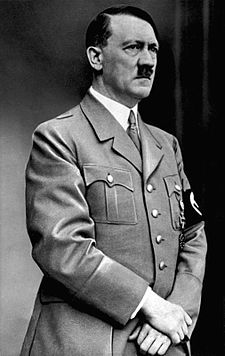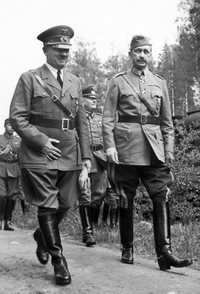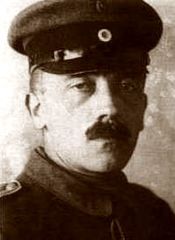- Military career of Adolf Hitler
-
The military career of Adolf Hitler can be divided into two distinct portions of Adolf Hitler's life. Mainly, the period during World War I when Hitler served as a Gefreiter (Lance Corporal) in the Bavarian Army, and the era of World War II when Hitler served as the Commander-in-Chief of the Wehrmacht through his position as Führer of Nazi Germany.
Contents
World War I
When Hitler was twenty-five years old in 1914, both Austria-Hungary and the German Empire became involved in the First World War (alhough Hitler at that time was still an Austrian citizen), had already developed strong Pan-Germanism ideals and instead of serving in the military of his native country, he crossed the border into Germany to serve in a Bavarian Regiment.[clarification needed]
The German military at the time was a collection of national forces organized under the authority of the various German Kingdoms with the military establishment itself dominated by Prussia. The German General Staff were mostly German nobility and, years later, Hitler expressed his distaste for the "generals with 'vons' in front of their names".
During the war, Hitler served in France and Belgium in the 16th Bavarian Reserve Regiment (called Regiment List after its first commander); Hitler originally enlisted as a Schütze and was promoted once to the rank of Gefreiter. He was never deemed officer material with little to no prospect of advancing to Unteroffizier, the first of the non-commissioned officer ranks.
Hitler's primary duty was as a message runner on the Western Front, "a relatively safe job" based at regimental headquarters, several miles from the Front.[1] According to research by Dr Thomas Weber of the University of Aberdeen, earlier historians of the period had not distinguished between regimental runners who were based away from the front "in relative comfort", and company or battalion runners who moved among the trenches and were often subjected to machine gun fire.[1]
Hitler was present at a number of major battles, including the First Battle of Ypres, the Battle of the Somme, the Battle of Arras and the Battle of Passchendaele.[2] The Battle of Ypres (October 1914), which became known in Germany as the Kindermord bei Ypern (Massacre of the Innocents) saw approximately 40,000 men (between a third and a half) of the nine infantry divisions present killed in 20 days, and Hitler's own company of 250 reduced to 42 by December. Biographer John Keegan has said that this experience drove Hitler to become aloof and withdrawn for the remaining years of war.[3]
Hitler was twice decorated for bravery. He received the relatively common Iron Cross, Second Class, in 1914 and Iron Cross, First Class, in 1918, an honour rarely given to a Gefreiter.[4] According to Weber, Hitler's First Class Iron Cross was recommended by Hugo Gutmann, a Jewish List adjutant, and this rarer award was commonly awarded to those posted to regimental headquarters, such as Hitler, who had more contact with more senior officers than combat soldiers.[1]
On 15 October 1918, Hitler was admitted to a field hospital, temporarily blinded by a mustard gas attack. Hitler was a hospital patient when the war ended, and was outraged by the subsequent Treaty of Versailles, which deprived Germany of various territories, demilitarised the Rhineland and imposed other economically damaging sanctions. In the book, The Mind of Adolf Hitler, it is said: There was the vision he (Hitler) had while in hospital at Pasewalk suffering from blindness allegedly caused by gas. Hitler said "When I was confined to bed, the idea came to me that I would liberate Germany, that I would make it great. I knew immediately that it would be realized." [5]
Following a near total demilitarisation of the armed forces, Hitler attempted to remain in the Army after the war. He was assigned by Army intelligence to monitor radical political groups in Munich, which is how Hitler first became exposed to the Nazi Party. The Army at the time did not see the Nazis as a "threat" and Hitler was ordered to ignore this small group and seek elsewhere for insurgents. Hitler, however, was enthralled by the Party and ceased reporting to his Army superiors in late 1919. The Army at the time had no formal discharge system in place, and so Hitler was simply left on the Army rolls as an inactive Gefreiter.
Paramilitary career
 Hitler wearing the brown uniform of Führer und Reichskanzler, a title Hitler assumed for himself on merging the offices of Chancellor and President.
Hitler wearing the brown uniform of Führer und Reichskanzler, a title Hitler assumed for himself on merging the offices of Chancellor and President.
After Hitler became the leader of the Nazi party, he quickly began acquiring paramilitary like titles and using Nazi Party paramilitary uniforms to denote his position. Hitler's main title within the Nazi party was simply that of Führer and there was never any special uniform designed for Hitler's position, although a rank pin for a civilian lapel (used by Hitler until 1934) was known as the "Eagle of Sovereignty Pin".[6] Hitler ceased wearing this pin after the Night of Long Knives due to widespread issuance of the Golden Party Badge and Hitler's preference for this decoration.
The brown Nazi Party uniform that Hitler is most often associated with was a paramilitary uniform of the SA and denoted Hitler's position as Oberste SA-Führer. In the late 1920s, Hitler occasionally wore a black uniform, but this was during a period when Hitler was emulating Benito Mussolini. Hitler's admiration for the Italian dictator later faded as Germany became more powerful than her Italian ally and Mussolini was, in the end, looked down upon by Hitler as a puppet-dictator under German control.
From 1933 to 1934, Hitler held the political position as Chancellor of Germany and it is during this period that Hitler is most often seen in newsreels and photographs as wearing civilian clothes. After the death of President of Germany Paul von Hindenburg, Hitler declared himself Führer und Reichskanzler and adopted a brown uniform, similar to his earlier SA uniform, but with a much cleaner cut and using an office like jacket instead of a closed collar stormtrooper shirt.
Hitler was, by default as Führer, the supreme commander of every Nazi paramilitary organization but Hitler never adopted extra ranks in these organizations nor did he have special uniforms to denote his position (for instance, there was no special SS uniform or insignia for Hitler, even though he was considered SS member #1 and outranked Heinrich Himmler). Hitler also technically qualified for every Nazi political decoration, but in practice only wore his World War I Iron Cross, the Golden Nazi Party Pin, and the Wound badge in Black. During Nazi rallies at Nuremberg in the early 1930s, Hitler temporarily wore the 1929 Nuremberg Party Day Badge, but discontinued this after about 1935.
World War II
When World War II began, Hitler appointed himself to the unique title "First Soldier of the Reich" and began wearing a gray military jacket with swastika eagle sewn on the upper left sleeve (anachronistic depictions in movies and popular culture notwithstanding, Hitler did not wear a brown Nazi party uniform at any point during World War II). Throughout the war, the only military decorations Hitler displayed were his Wound Badge and Iron Cross from World War I and the Golden Nazi Party Badge.
Hitler's position in World War II was essentially supreme commander of the German Armed Forces. In 1941, Hitler further appointed himself Commander-in-Chief of the German Army, thus taking a direct operational posting usually held by a full German General.
Awards and decorations of Adolf Hitler
 Adolf Hitler's gray uniform jacket, worn during the Second World War. The Iron Cross, Wound Badge, and Gold Nazi Party Pin were the only awards Hitler wore on a daily basis.
Adolf Hitler's gray uniform jacket, worn during the Second World War. The Iron Cross, Wound Badge, and Gold Nazi Party Pin were the only awards Hitler wore on a daily basis.
Awards from World War I
Both of Hitler's World War I awards were always displayed on his various uniforms
- Iron Cross (First and Second Class)
- Wound Badge (in Black)
Nazi Party Political Decorations
The political awards listed below are those Hitler recognized as having received and wore on his various political uniforms. By 1938, the Golden Party Badge was the only award he wore on a regular basis.
The Eagle of Sovereignty Pin was a civilian lapel pin which denoted Hitler's rank of Führer; Hitler appears to have worn this lapel pin for social occasions between 1933 and 1935.
Political Awards bestowed but not displayed
Hitler was technically entitled to several additional Nazi Party political decorations and had full rights to display such awards on his uniform. The decorations listed below were technically awarded to Hitler, but were never displayed on his uniforms.
- NSDAP Long Service Award (25 years)
- Nazi Gau Badges[7]
- Golden Hitler Youth Badge (with oak-leaves)[8]
- Honour Chevron for the Old Guard
Civilian decorations of Nazi Germany
Hitler never displayed any German civil decorations, and in fact did not qualify for most of them. Technically, Hitler was awarded the Olympic Games Decoration for serving as host to the 1936 Olympics, but never displayed or even acknowledged having received this award.
Military decorations of World War II
Hitler's stance on World War II military decorations was that the Nazi leadership was the "spring" from which awards were granted and Hitler, along with other senior Nazis, did not need to bestow high ranking medals and awards on themselves, but should rather reserve such decorations for the younger generation of the movement. This was a point of contention between Hitler and Hermann Göring, the latter of which attempted during World War II to amass every conceivable German military, civil, and political decoration for display on his Luftwaffe uniform. Göring's attempt at self award bestowal reached a head in 1944, when Hitler denied the German Reichsmarschall the award of the Knights Cross of the War Merit Cross, which Göring had attempted to obtain as an award for his various government and military service.
Hitler himself was never a recipient of a high level World War II military decoration, such as the 1939 Iron Cross, Knight's Cross of the Iron Cross, German Cross, or War Merit Cross. By his appointment as Supreme Commander of the Wehrmacht and Commander-in-Chief of the Army, however, Hitler automatically qualified for some military service decorations, although Hitler never wore such awards or even acknowledged his right to display them.
In all, the following were World War II military decorations Hitler was automatically awarded by default:
- Cross of Honor
- Anschluss Medal
- Sudetenland Medal (w/Prague castle bar)
- Memel Medal
- West Wall Medal (w/1944 bar)
Of interest is that Hitler was in fact disqualified from receiving the Eastern Front Medal since, although he had planned the campaign, Hitler did not have enough time on the front lines to merit the award. Due to the July 20 Plot, Hitler also automatically qualified for the "Wound Badge of 20 July 1944" although he never displayed this medal, choosing instead to wear his Wound Badge in Black from the First World War.
References
- ^ a b c "Adolf Hitler a war hero? Anything but, said first world war comrades: Unpublished letters and diaries from List regiment soldiers portray Hitler as a loner, an object of ridicule and 'a rear area pig'", The Guardian, August 16, 2010
- ^ Shirer 1990, p. 53
- ^ Keegan 1987, p. 239
- ^ Bullock 1962, p. 52
- ^ "The Mind of Adolf Hitler",Walter C. Langer, New York 1972 p.37
- ^ Speer, Albert, Inside the Third Reich, Macmillan (New York and Toronto), 1970, ISBN 0297000152. Republished in paperback in 1997 by Simon & Schuster, ISBN 978-0-684-82949-4
- ^ Hitler was automatically entitled to the highest degree of every Nazi Party Gau (District) Badge. Some Gauleiters ordered "special degrees" of Gau Badges, specifically for Hitler, some of which were gold encrusted with diamonds. Hitler was formally presented many of these badges, but wore none of them (in all, there were eleven Gau badges to which Hitler was entitled).
- ^ Some reports indicate that Hitler did indeed wear this pin at various Hitler Youth functions.
- Zentner, Christian Ed; Bedürftig, Friedemann Ed (1991), The Encyclopedia of the Third Reich, New York: Macmillan. ISBN 0028975022.
Adolf Hitler Politics - Political views
- Political directives
- Speeches
- Mein Kampf
- Zweites Buch
- Last will and testament

Events - Military career
- Rise to power
- Cabinet Hitler
- Third Reich
- World War II
- The Holocaust
- Assassination attempts
- Death
Places of residence - Brown House
- Berghof (Kehlsteinhaus)
- Reich Chancellery
- Wolf's Lair
- Wehrwolf
- Adlerhorst
- Private train
- Führerbunker
- Wolfsschlucht I
- Wolfsschlucht II
- Anlage Süd
- Felsennest
Civilian residencesPersonal life - Reichssicherheitsdienst, 1st SS Division Leibstandarte SS Adolf Hitler (Bodyguards)
- Health
- Religious views
- Sexuality
- Hitler's Table Talk
- Vegetarianism
- 50th birthday
Personal belongings - Blondi (dog)
- Hitler's Globe
- Private library
Family Categories:- Adolf Hitler
- Military careers
Wikimedia Foundation. 2010.



